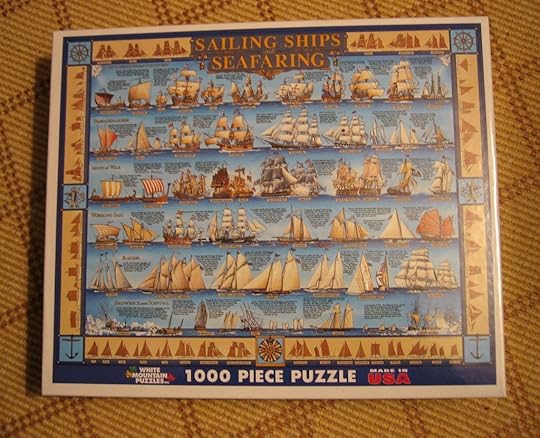With wind alone…
It's been hectic for the last few weeks, between getting the last book to print, preparing to launch into the next big project aboard the boat, and travelling, so I haven't been online much and this post is coming to you from on the road, presently on a stop-over with family in Cape Cod. Yesterday I needed a few odds and ends, so my daughter and I ran down the road to the local hardware/home and garden store, and in the process we came across a jigsaw puzzle we couldn't pass up. Like of much what is aimed at the tourist crowds that surge through here in the coming months, it has a nautical tone: in this case 'Sailing Ships and Seafaring'. Row upon row of sailing ships of every variety imaginable make up the illustration, from exploration and discovery to passage makers, ships of war, working sail, racing, and even shipwrecks and survival, and each group shows specific examples from through the centuries from all corners of the world, with short explanations for each. Phoenician traders, Viking knarrs, Polynesian canoes, Chinese junks, Arab dhows, Spanish Galleons, whalers and grand tea clippers. The puzzle's border shows a range of smaller craft from catboats and sloops through to topsail schooners, brigantines and barques.
My daughter was fascinated by the range and variety of vessels that had evolved from the simple concept of wind propelling a floating object, and that led to an interesting discussion of the evolution of indigenous craft. It is much like comparing a hawk to a hummingbird and a gull to a bat or a bumblebee. All have wings, all fly, but each has evolved to a specialized design determined by its environment and purpose. And while my personal favorite, the catboat, might be an ideal craft for these Cape Cod waters, it's not exactly the best boat for San Francisco Bay. Viking ships, with their symmetrical bow and stern, could change direction in an instant, a critical trait for navigating ice-strewn passages. They were built to be highly seaworthy yet fast and light, and could be beached and carried over land as need be. The Chinese junk design dates back over 2,000 years, yet is still used to this day and recognized for its exceptional seagoing capabilities and unique sail characteristics. Majestic clippers evolved to carry pricey cargo such as tea, spices, silk and opium along ocean trade routes, and these swift, slender ships sacrificed carrying capacity for speed, often riding the trade winds at over sixteen knots. It wasn't until the age of steam that these beautiful ships were driven to extinction.
A few years back a fellow stopped off at the boatyard where I had worked; he was traveling down river in a beat-up old canoe full of car batteries and propelled by an electric trolling motor. He needed a place to tie up so he could plug in and recharge his batteries. Oddly enough, his supposedly unplanned arrival was met by the local media, who it seems had been expecting him and covering his newsworthy trip from Canada to Florida "without the use of any internal combustion engine". Apparently I wasn't aware that this was such a notable accomplishment; when one reporter asked me what I thought of the environmental statement he was making, I shrugged and replied that I didn't see the big deal. People had been circling the globe since the dawn of civilization without the aid of engines. The reporter seemed a bit surprised; I don't think that was the answer she'd expected. I pointed out to the river at the gaff-rigged packet sloop Clearwater ghosting past on a light breeze and said "What do you think that's running on right now?"
Much of the world's exploration, work, trade and battles throughout history have taken place with only the wind and water to drive them forward. In this day of instant information and modern high-speed international transportation, borders have become blurred and many forget how civilization grew on this basic method of transportation.
Share on Facebook




